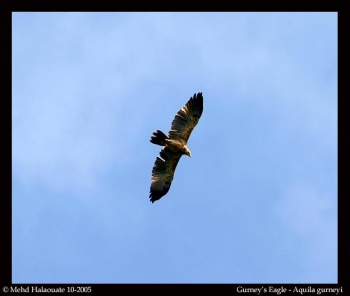(Picture of perched bird. Additional information added. All sections now started. References. Incomplete gone) |
(added to ==Identification==, references, updated clements ref, moved second photo up) |
||
| Line 2: | Line 2: | ||
;[[:Category:Aquila|Aquila]] gurneyi | ;[[:Category:Aquila|Aquila]] gurneyi | ||
==Identification== | ==Identification== | ||
| − | 66–86 cm | + | 66–86 cm, 26-33.9 inches. <br />Wingspan 165–185 cm. Immature female 3060 g |
| + | ====Adult==== | ||
*Blackish-brown plumage overall | *Blackish-brown plumage overall | ||
| − | *[[Topography#Legs_and_Feet| | + | *[[Topography#Heads|Cere]] grey brown |
| + | *In comparison to other ''[[Aquila]]'', | ||
| + | :*Paler [[Topography#Legs_and_Feet|tarsal]] feathers | ||
| + | :*Slimmer legs | ||
| + | :*Shorter wings | ||
| + | :*Longer tail | ||
| + | ====Juvenile==== | ||
| + | *Browner above with grey brown marbling | ||
| + | *Underparts getting lighter with creamy abdomen and legs | ||
| + | *Third and fourth year plumage has less marbled upperparts, lighter brown or cream head and underparts | ||
| + | [[Image:Gurneys_Eagle.jpg|thumb|350px|right|Photo by mehd halaouate<br />Biak, [[Papua]], [[Indonesia]], October 2005]] | ||
| + | ====Similar species==== | ||
| + | *[[Wedge-tailed Eagle]] have | ||
| + | :*Less yellow feet | ||
| + | :*Shorter, less rounded tail | ||
| + | :*More reddish brown in colour | ||
| + | *In [[Moluccas]] the [[Black Eagle]] is different for the following reasons; | ||
| + | :*Slighty smaller (70-80 cm) | ||
| + | :*Wings are narrower at the base giving a more paddle shaped appearance | ||
| + | :*Variable amounts of white on the rump, around the beak, and eyes | ||
| + | :*A more distinct white patch at the base of the primaries | ||
| + | :*Male is between 2% and 11% smaller than female (wingspan 510–520 mm, 530–568 mm in female) | ||
| + | :*Bare parts darker yellow | ||
| + | :*Iris darker yellow, brown changeing to pale yellow in Juvenile | ||
| + | *Juvenile [[White-bellied Sea-Eagle]] normally has a much paler rump, underwing and undertail | ||
| + | |||
==Distribution== | ==Distribution== | ||
[[New Guinea]], the Aru Islands and northern Maluku (Moluccas). Recorded in the Cyclops Mountains, on Biak Island and the Vogelkop Peninsula in Irian Jaya and near Vanimo in [[Papua New Guinea]]. | [[New Guinea]], the Aru Islands and northern Maluku (Moluccas). Recorded in the Cyclops Mountains, on Biak Island and the Vogelkop Peninsula in Irian Jaya and near Vanimo in [[Papua New Guinea]]. | ||
==Taxonomy== | ==Taxonomy== | ||
| − | |||
This is a [[Dictionary_M-S#M|monotypic]] species<sup>[[#References|[1]]]</sup>. | This is a [[Dictionary_M-S#M|monotypic]] species<sup>[[#References|[1]]]</sup>. | ||
==Habitat== | ==Habitat== | ||
| Line 19: | Line 44: | ||
They are known to build a large stick nest high in a tree, but little other information is available. | They are known to build a large stick nest high in a tree, but little other information is available. | ||
==References== | ==References== | ||
| − | #{{Ref- | + | #{{Ref-Clements6thAug15}}#Handbook of the Birds of the World Alive (retrieved August 2015) |
| + | #Raptors of the World, James Ferguson-Lees and David Christie. ISBN 9780713669572 | ||
{{ref}} | {{ref}} | ||
==External Links== | ==External Links== | ||
Revision as of 07:21, 18 August 2015
- Aquila gurneyi
Identification
66–86 cm, 26-33.9 inches.
Wingspan 165–185 cm. Immature female 3060 g
Adult
- Paler tarsal feathers
- Slimmer legs
- Shorter wings
- Longer tail
Juvenile
- Browner above with grey brown marbling
- Underparts getting lighter with creamy abdomen and legs
- Third and fourth year plumage has less marbled upperparts, lighter brown or cream head and underparts
Similar species
- Wedge-tailed Eagle have
- Less yellow feet
- Shorter, less rounded tail
- More reddish brown in colour
- In Moluccas the Black Eagle is different for the following reasons;
- Slighty smaller (70-80 cm)
- Wings are narrower at the base giving a more paddle shaped appearance
- Variable amounts of white on the rump, around the beak, and eyes
- A more distinct white patch at the base of the primaries
- Male is between 2% and 11% smaller than female (wingspan 510–520 mm, 530–568 mm in female)
- Bare parts darker yellow
- Iris darker yellow, brown changeing to pale yellow in Juvenile
- Juvenile White-bellied Sea-Eagle normally has a much paler rump, underwing and undertail
Distribution
New Guinea, the Aru Islands and northern Maluku (Moluccas). Recorded in the Cyclops Mountains, on Biak Island and the Vogelkop Peninsula in Irian Jaya and near Vanimo in Papua New Guinea.
Taxonomy
This is a monotypic species[1].
Habitat
Coastal and swamp forests and forest edges.
Behaviour
Very little-known and rarely seen.
Diet
There is not much information available but one individual observed feeding on a possum species.
Breeding
They are known to build a large stick nest high in a tree, but little other information is available.
References
- Clements, J. F., T. S. Schulenberg, M. J. Iliff, D. Roberson, T. A. Fredericks, B. L. Sullivan, and C. L. Wood. 2015. The eBird/Clements checklist of birds of the world: v2015, with updates to August 2015. Downloaded from http://www.birds.cornell.edu/clementschecklist/download/
- Handbook of the Birds of the World Alive (retrieved August 2015)
- Raptors of the World, James Ferguson-Lees and David Christie. ISBN 9780713669572
Recommended Citation
- BirdForum Opus contributors. (2025) Gurney's Eagle. In: BirdForum, the forum for wild birds and birding. Retrieved 7 January 2025 from https://www.birdforum.net/opus/Gurney%27s_Eagle





